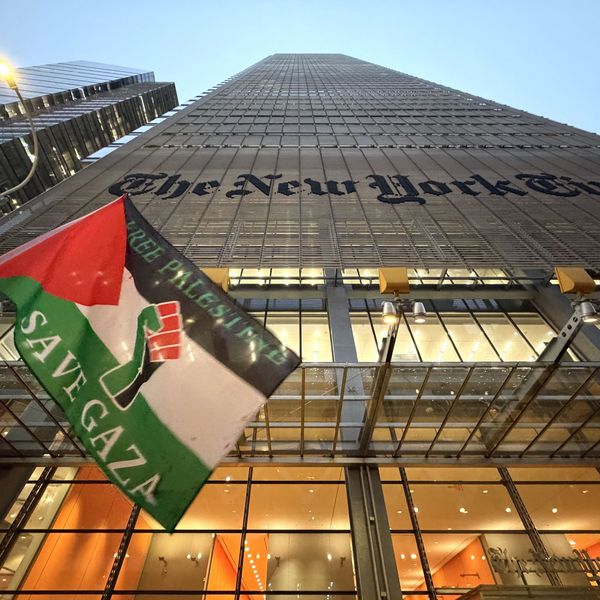The NYT Finds Heroes in Tbilisi -- In Baghdad, Only Terrorists
The New York Times ran a feature August 12, on Georgian civilians who've joined the fight against the Russian invasion of that former Soviet republic. The story, by Nicholas Kulish and Michael Schwirtz is full of empathy and heart.
Nika Kharadze and Giorgi Monasalidze went to war last week, the Times report begins, "even though they were not warriors."
It goes on to describe how the men's parents have been searching for them ever since. They've gone from hospital to hospital, to the local and International Red Cross. Mom and dad even asked the cellphone company to trace the last known location of their son's phone. No luck.
And then there's this line: as parts of the country fell before the Russian invaders, the Times writes, "it was not only the army that rose in its defense but also regular citizens." Resistance, we learn, was part of a tradition, inscribed in local history and culture going back to "medieval times."
To make the point, the writers describe a government employee, standing under a statue of Stalin in the city's main square with a rifle slung over his civilian clothes. The man is part of a group of a dozen locals who tell the reporter they're there to defend their town.
The story also describes displacement caused by bombing. "The planes came in and they started to bomb. The ground was covered with dead people, and there was nowhere to go," says Goderzi Zenashvili, 48. "The people that died, they died from their houses falling in on them, from the shrapnel and from concussions."
So now we know! The New York Times can do it when they want to. They can paint a picture of war that's hard to shake: heroic, hapless young men who take up arms to defend their homelands; moms and dads and lovers worried sick. The Times can explain how invading armies provoke righteous resistance.
But they didn't -- not when it was Baghdad instead of Tbilisi, and the statue Saddam's, not Stalin's. Then, local people in resistance were called dead enders, killers, terrorists. Because of course -- here's the difference: then the resisters were the enemy and the invaders were -- are -- us.
An Urgent Message From Our Co-Founder
Dear Common Dreams reader, The U.S. is on a fast track to authoritarianism like nothing I've ever seen. Meanwhile, corporate news outlets are utterly capitulating to Trump, twisting their coverage to avoid drawing his ire while lining up to stuff cash in his pockets. That's why I believe that Common Dreams is doing the best and most consequential reporting that we've ever done. Our small but mighty team is a progressive reporting powerhouse, covering the news every day that the corporate media never will. Our mission has always been simple: To inform. To inspire. And to ignite change for the common good. Now here's the key piece that I want all our readers to understand: None of this would be possible without your financial support. That's not just some fundraising cliche. It's the absolute and literal truth. We don't accept corporate advertising and never will. We don't have a paywall because we don't think people should be blocked from critical news based on their ability to pay. Everything we do is funded by the donations of readers like you. Will you donate now to help power the nonprofit, independent reporting of Common Dreams? Thank you for being a vital member of our community. Together, we can keep independent journalism alive when it’s needed most. - Craig Brown, Co-founder |
The New York Times ran a feature August 12, on Georgian civilians who've joined the fight against the Russian invasion of that former Soviet republic. The story, by Nicholas Kulish and Michael Schwirtz is full of empathy and heart.
Nika Kharadze and Giorgi Monasalidze went to war last week, the Times report begins, "even though they were not warriors."
It goes on to describe how the men's parents have been searching for them ever since. They've gone from hospital to hospital, to the local and International Red Cross. Mom and dad even asked the cellphone company to trace the last known location of their son's phone. No luck.
And then there's this line: as parts of the country fell before the Russian invaders, the Times writes, "it was not only the army that rose in its defense but also regular citizens." Resistance, we learn, was part of a tradition, inscribed in local history and culture going back to "medieval times."
To make the point, the writers describe a government employee, standing under a statue of Stalin in the city's main square with a rifle slung over his civilian clothes. The man is part of a group of a dozen locals who tell the reporter they're there to defend their town.
The story also describes displacement caused by bombing. "The planes came in and they started to bomb. The ground was covered with dead people, and there was nowhere to go," says Goderzi Zenashvili, 48. "The people that died, they died from their houses falling in on them, from the shrapnel and from concussions."
So now we know! The New York Times can do it when they want to. They can paint a picture of war that's hard to shake: heroic, hapless young men who take up arms to defend their homelands; moms and dads and lovers worried sick. The Times can explain how invading armies provoke righteous resistance.
But they didn't -- not when it was Baghdad instead of Tbilisi, and the statue Saddam's, not Stalin's. Then, local people in resistance were called dead enders, killers, terrorists. Because of course -- here's the difference: then the resisters were the enemy and the invaders were -- are -- us.
The New York Times ran a feature August 12, on Georgian civilians who've joined the fight against the Russian invasion of that former Soviet republic. The story, by Nicholas Kulish and Michael Schwirtz is full of empathy and heart.
Nika Kharadze and Giorgi Monasalidze went to war last week, the Times report begins, "even though they were not warriors."
It goes on to describe how the men's parents have been searching for them ever since. They've gone from hospital to hospital, to the local and International Red Cross. Mom and dad even asked the cellphone company to trace the last known location of their son's phone. No luck.
And then there's this line: as parts of the country fell before the Russian invaders, the Times writes, "it was not only the army that rose in its defense but also regular citizens." Resistance, we learn, was part of a tradition, inscribed in local history and culture going back to "medieval times."
To make the point, the writers describe a government employee, standing under a statue of Stalin in the city's main square with a rifle slung over his civilian clothes. The man is part of a group of a dozen locals who tell the reporter they're there to defend their town.
The story also describes displacement caused by bombing. "The planes came in and they started to bomb. The ground was covered with dead people, and there was nowhere to go," says Goderzi Zenashvili, 48. "The people that died, they died from their houses falling in on them, from the shrapnel and from concussions."
So now we know! The New York Times can do it when they want to. They can paint a picture of war that's hard to shake: heroic, hapless young men who take up arms to defend their homelands; moms and dads and lovers worried sick. The Times can explain how invading armies provoke righteous resistance.
But they didn't -- not when it was Baghdad instead of Tbilisi, and the statue Saddam's, not Stalin's. Then, local people in resistance were called dead enders, killers, terrorists. Because of course -- here's the difference: then the resisters were the enemy and the invaders were -- are -- us.

